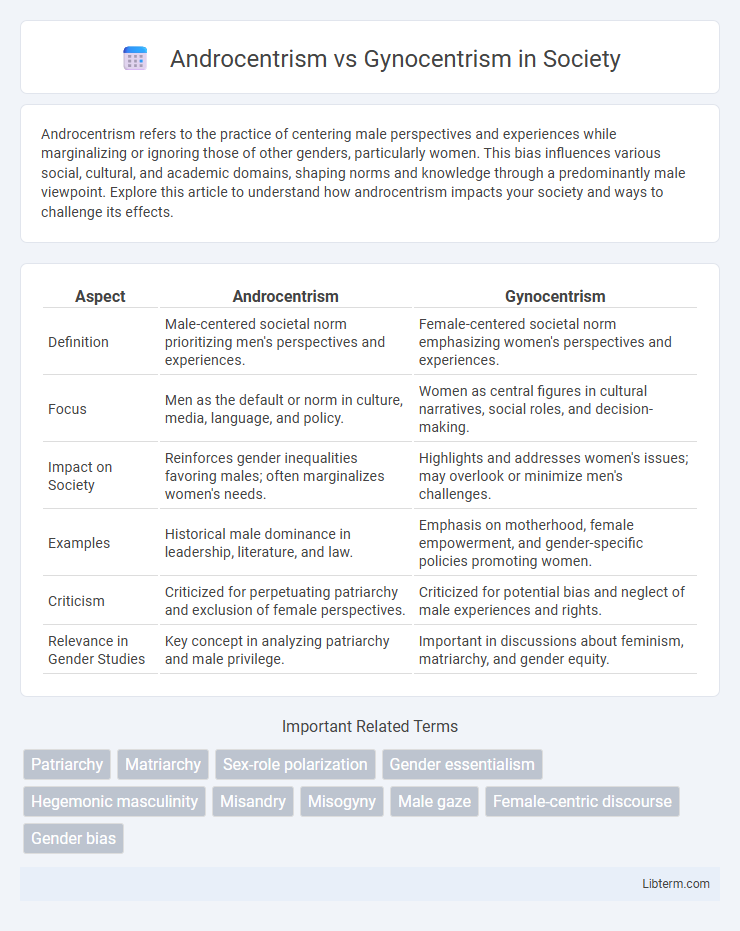Androcentrism refers to the practice of centering male perspectives and experiences while marginalizing or ignoring those of other genders, particularly women. This bias influences various social, cultural, and academic domains, shaping norms and knowledge through a predominantly male viewpoint. Explore this article to understand how androcentrism impacts your society and ways to challenge its effects.
Table of Comparison
| Aspect | Androcentrism | Gynocentrism |
|---|---|---|
| Definition | Male-centered societal norm prioritizing men's perspectives and experiences. | Female-centered societal norm emphasizing women's perspectives and experiences. |
| Focus | Men as the default or norm in culture, media, language, and policy. | Women as central figures in cultural narratives, social roles, and decision-making. |
| Impact on Society | Reinforces gender inequalities favoring males; often marginalizes women's needs. | Highlights and addresses women's issues; may overlook or minimize men's challenges. |
| Examples | Historical male dominance in leadership, literature, and law. | Emphasis on motherhood, female empowerment, and gender-specific policies promoting women. |
| Criticism | Criticized for perpetuating patriarchy and exclusion of female perspectives. | Criticized for potential bias and neglect of male experiences and rights. |
| Relevance in Gender Studies | Key concept in analyzing patriarchy and male privilege. | Important in discussions about feminism, matriarchy, and gender equity. |
Defining Androcentrism and Gynocentrism
Androcentrism refers to the practice of centering male perspectives and experiences as the default or norm in society, often resulting in the marginalization of female viewpoints. Gynocentrism, conversely, prioritizes female perspectives and experiences, sometimes leading to the undervaluing of male viewpoints. Both concepts highlight how cultural, social, and institutional biases shape gender-centered worldviews and influence power dynamics.
Historical Roots and Evolution
Androcentrism historically centered male experiences as the default in cultural, social, and political contexts, rooted in patriarchal societies dating back to ancient civilizations such as Mesopotamia and Greece. Gynocentrism emerged as a counter-narrative emphasizing female perspectives and values, gaining prominence during feminist movements in the 20th century that challenged male-dominated power structures. The evolution of these concepts reflects shifting gender dynamics, where contemporary discourse increasingly critiques androcentric biases while exploring gynocentric frameworks in social theory and feminism.
Cultural Manifestations in Society
Androcentrism manifests in societal structures through male-dominated cultural norms, media representation, and language that prioritizes male perspectives, shaping gender roles and expectations. Gynocentrism appears in cultural practices emphasizing female experiences and values, often influencing social policies and community dynamics centered around women's needs. Both frameworks impact power distribution, identity formation, and social interactions, reflecting deep-rooted biases in cultural narratives and institutional practices.
Impacts on Gender Roles and Expectations
Androcentrism, which centers male perspectives and experiences, often reinforces traditional gender roles by valuing masculinity over femininity, leading to expectations that men should be dominant and women submissive. Conversely, gynocentrism prioritizes female experiences, sometimes elevating women's roles and caregiving functions while potentially marginalizing male emotional expression and responsibilities. Both frameworks shape societal norms and behaviors, influencing how gender identities and roles are perceived and enacted across cultures.
Representation in Media and Literature
Androcentrism dominates media and literature, often centering male experiences and perspectives, which leads to the marginalization of female voices and stories. Gynocentrism, though less prevalent, prioritizes female viewpoints, sometimes resulting in underrepresentation of male experiences. This imbalance in representation affects cultural narratives, shaping societal norms and influencing gender equality discourse.
Effects on Policy and Decision-Making
Androcentrism often leads to policies and decisions that prioritize male perspectives, resulting in gender-biased outcomes such as wage gaps, underrepresentation of women in leadership, and insufficient attention to women's health issues. Gynocentrism, though less prevalent in policy contexts, can shift priorities towards female-centered initiatives, potentially marginalizing male concerns in areas like family law or education. Both paradigms influence legislative frameworks and resource allocations, shaping the social and economic landscape based on gendered assumptions.
Psychological and Social Consequences
Androcentrism often leads to the marginalization of female experiences, fostering gender stereotypes that can negatively impact women's mental health and self-esteem while reinforcing male privilege in social and professional contexts. Gynocentrism, on the other hand, may prioritize women's perspectives and needs, sometimes resulting in the undervaluation of male emotional expression and contributing to social stigmas around masculinity and vulnerability. Both perspectives influence societal norms and interpersonal dynamics, shaping psychological well-being by affecting identity formation, social inclusion, and access to resources.
Intersectionality with Other Forms of Bias
Androcentrism and gynocentrism intersect with other forms of bias such as racism, classism, and ableism, creating complex layers of discrimination that impact marginalized groups differently. Intersectionality reveals how gender biases are compounded by social identities, influencing access to resources, representation, and justice. Addressing these intertwined biases requires an inclusive approach that recognizes the multifaceted nature of oppression across gender and other social categories.
Strategies for Achieving Balance and Equity
Addressing androcentrism and gynocentrism requires implementing inclusive policies that promote gender equity in workplace and educational settings. Strategies include fostering dialogue that recognizes diverse gender perspectives and instituting transparent decision-making processes to mitigate bias. Empowering marginalized voices through mentorship programs and equitable resource allocation further supports balanced representation and systemic fairness.
Future Perspectives: Toward Inclusive Societies
Emerging discourses on androcentrism vs gynocentrism emphasize dismantling systemic biases to foster gender equity in political, social, and economic spheres. Future perspectives advocate for inclusive policies that recognize diverse gender identities and promote equal representation across institutions. Integrating intersectional approaches ensures that both androcentric and gynocentric tendencies evolve toward balanced, egalitarian societies.
Androcentrism Infographic

 libterm.com
libterm.com